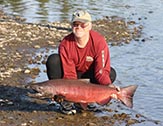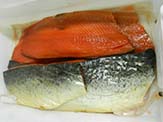Meats and Sausages
Salmon
Fish Recipes| Name | Protein % | Fat % | Water % |
| Salmon, Pink | 20.50 | 4.40 | 75.52 |
| Salmon, Chum | 20.14 | 3.77 | 75.38 |
| Salmon, Chinook | 19.93 | 10.43 | 71.64 |
| Salmon, Sockeye | 21.31 | 5.61 | 73.15 |
| Salmon, Coho | 21.62 | 5.93 | 72.66 |
| Salmon, Coho, farmed | 21.27 | 7.67 | 70.47 |
| Salmon, Atlantic | 19.84 | 6.34 | 68.50 |
| Salmon, Atlantic, farmed | 20.42 | 13.42 | 64.89 |
Salmon is the common name for several species of fish in the family Salmonidae. Other fish in the same family are called trout. All types of salmon contain a large percentage of fat, and that is why smoked salmon is so delicious.
There is Atlantic salmon, Pacific salmon, Australian salmon, Hawaiian salmon, Indian salmon, Danube European salmon, the fish can be found everywhere. The size varies with species and can range from 50 cm, 6.8 kg for pink and Sockeye salmon to 120 cm, 46.8 kg for Atlantic salmon.
General Guidelines
All salmon species are suitable for smoking. The whole fish should be carefully gutted and the belly cavity cleaned out. The contents of the belly cavity can constitute up to 25 per cent of the weight of the fish as caught. Congealed blood in and around the main vein along the backbone should be removed; a large spoon is often suitable for this purpose. The belly cavity should then be well washed.
After gutting, the head is removed by cutting round inside the gills, then breaking or cutting through the backbone. Two single fillets, are cut, each complete with nape or shoulder bone, and belly flap. The nape bone gives strength to the fillet during handling, and provides support if the fillet is to be hung for smoking, although most fillets nowadays are smoked on trays. The belly bones and covering membrane can be carefully removed from each fillet to enhance appearance, although some smokers prefer to leave them on. As much blood as possible is removed from veins by pressing them gently inwards, and any blood on the surface of the fillet is wiped away with cold water; blood left on the fillet becomes black and unattractive in appearance when the fillet is smoked.
Cold Smoked Salmon
The whole salmon are gutted; the fish are beheaded and filleted. The lug bones are left on fillets to provide strong support for the hanging loop, although most fillets nowadays are smoked on trays. String is threaded through the shoulder of each fillet under the lug bones to form a loop. The lug bones are not needed when the fillets are lied down on a screen. Salt can be added to salmon fillets either by brining or by dry salting. Brining may give a better gloss, but almost all producers prefer dry salting because subsequent drying/smoking time in the smokehouse is shorter. Brined fillets, which lose no weight during brining, need about twice as long in the smokehouse to give the same total weight loss.
To allow the salt to penetrate the fillet more evenly, the skin can be scorched at the thickest part of the fillet with a razor blade without cutting the meat. Three cuts are made that just penetrate the skin on the fillet, each about 2” long across the width of the fillet at the thickest part to allow uniform salt penetration, the slits being packed with salt. The fillets are placed on a layer of salt 1 inch thick. The cut side of the fillet is covered with another layer of salt about 1/2 inch deep at the thick end tapering down to the tail. At the thinnest part of the tail the salt is only lightly sprinkled over. Additional alternate layers of fillets and salt can be laid on top of the first layer until the stack is complete. Typical times in practice are about 12 hours for fillets from a 4 kg salmon, and 24 hours for fillets from an 8 kg salmon, but the time will vary to some extent depending on initial quality and fat content. The accumulating pickle should be drained away.
Note: There are cures that include small amounts of brown sugar, molasses and rum to introduce a distinctive flavor, but the majority of producers use only salt.
- Salting times:
- 1.5 - 2 lb fillet (0.75 inch) - 12 hours
- 3 - 4 lb fillet (1 inch) - 16 hours
- 5 lb fillet (1.5 inch) - 24 hours
By this stage the fillets should feel firm and springy, rather like bacon, when pressed with the fingers, having lost the stiffness they had when taken out of dry salt. The salmon fillets, are either hung on (enters by means of string loops through the shoulders or are laid on trays made of plastics coated or stainless steel wire mesh. Hanging has the disadvantage that it tends to stretch a heavy fillet and cause its flesh to gape (separate). Salted fillets are washed in cold water to remove surplus salt from the surface and then immersed in 30° brine for 1/2 hour depending on size to even out the salt distribution. (Add 0.71 lb of salt to 1 gallon of water. This makes 30 degrees brine).
- The fillets are hung up to drip.
- The fillets are dried at 80° F (27° C) in a smokehouse (no smoke needed) for 4 hours.
- The fillets are smoked with thin smoke at 80° F (27° C) for 12 hours.
In the last 20 minutes of smoking the temperature may be raised for 20 minutes to 92° F (33° C) to bring oil to the surface which gives fillets an attractive appearance. If fillets on removal from the smokehouse are found to be too soft and flabby, they should be returned to the smokehouse and dried more. The finished product should have a consistency rather like that of boiled ham, not too dry and fibrous, and be easily sliced. The shelf life of refrigerated smoked salmon is 5-6 days. Medium cured salmon should loose 7-9% of weight during dry salting and additional 7-9% during smoking; a combined weight loss of 16-18%.
Salmon - Nova Lox - Cold Smoked
- Mix one part brown sugar with one part of salt.
- The fillets are placed skin down on a layer of salt/sugar about 1 inch thick.
- Thoroughly cover fillets with the mixture on top.
- Add more layers in the same manner, place the last fillets skin up and cover with more mix.
- Salting times:
- 0.75 inch - 9 hours
- 1 inch - 12 hours
- 1.5 inch - 18 hours
- 2 inch - 24 hours
- Rinse fillets to remove surplus salt from the surface and drain.
- Now, immerse fillets in 80° brine.
- Place fillets in cold water: thin fillets - 60 minutes, thick fillets - 120 minutes. Change water 1-2 times. Drain.
- Dry at < 80° F (26° C) for 60 minutes.
- Smoke with a thin smoke at < 80° F (26° C) for 12 - 16 hours.
Cold Smoked Salmon
This recipe uses 2:1 salt to brown sugar.
Make 80º brine first, then add brown sugar. For example, to 1 gallon of water you will add 2.2 pounds of salt and 1.1 pound of brown sugar. The solution is denser now, and will show as 95º brine on salinometer. If you like spices, for example dill or bay leaf, add them now. Place fillets in the brine.
Brining times:
- 0.75 inch - 9 hours
- 1 inch - 12 hours
- 1.5 inch - 18 hours
- 2 inch - 24 hours
Place fillets in cold water: thin fillets - 60 minutes, thick fillets - 120 minutes. Change water 1-2 times. Drain.
Place in refrigerator for 12 hours. Salt will equalize inside fillets and their surfaces will dry.
Smoke at 70° F (22° C) for 12 - 16 hours, depending on size.
Hot Smoked Salmon
- Place salmon fillets for 1 - 2 hours in 80 degrees brine: (Add 2.2 lbs of salt to 1 gallon of water. This makes 80 degrees brine).
- 0.75 inch - 30 min
- 1 inch - 60 minutes
- 1.5 inch - 90 minutes
- 2 inch - 120 minutes
- Remove the fish from the brine and rinse it quickly under cold running water. Drain.
- Rub screens with a cloth soaked with vegetable oil.
- Place the screens in smokehouse preheated to 100° F (38° C) for 1 hour.
- Start smoking at 100° F (38° C) for 60 minutes. Increase the temperature to 176° F (80° C).
- Smoke at 176° F (80° C) for 60 minutes. Thick fillets may need more time.
- Cool to room temperature.
- * You can use sugar brine (see Cold Smoked Salmon above).















